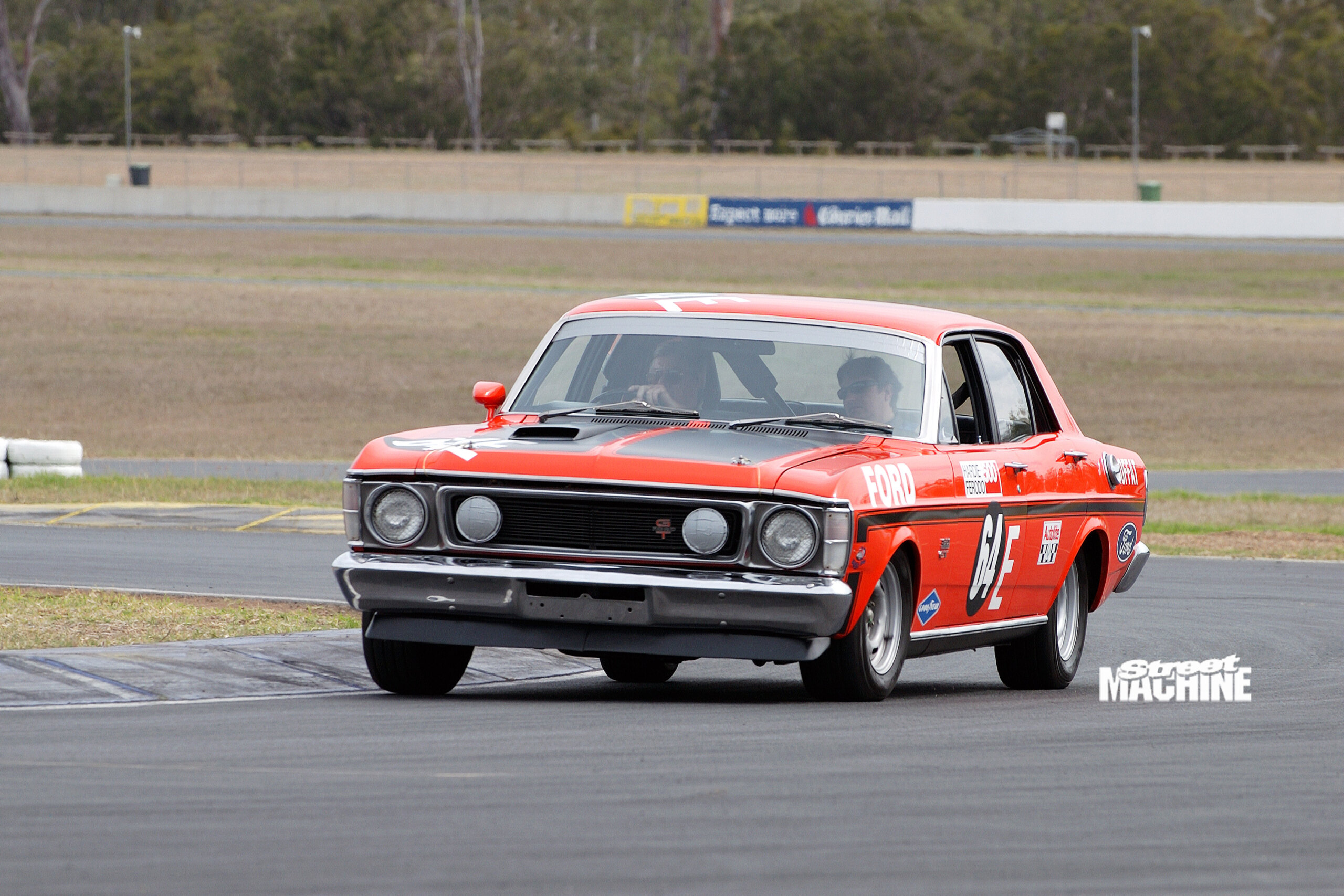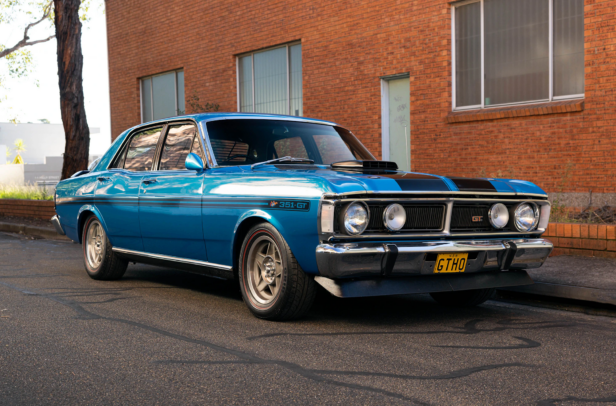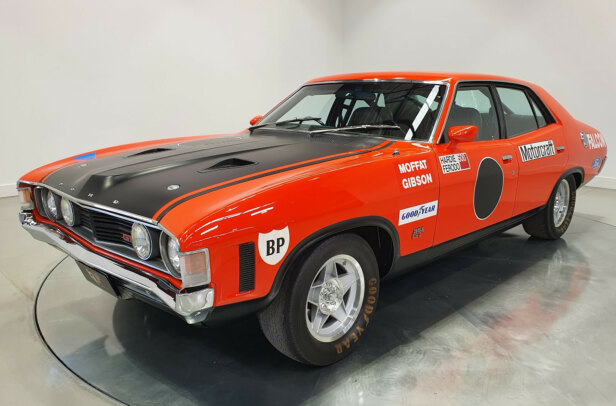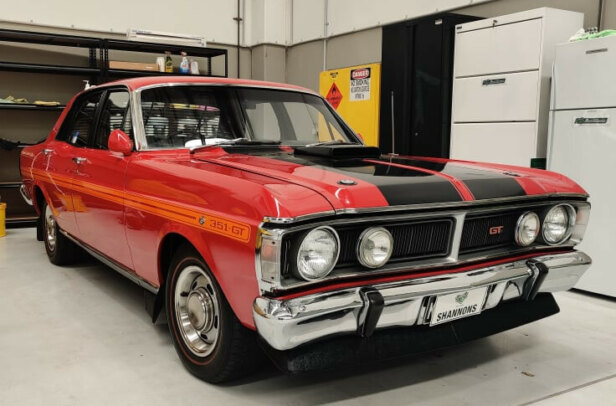Of all the Australian muscle cars, the Falcon GTHO is the most revered. In the heyday of win-on-Sunday, sell-on-Monday marketing, Ford Australia developed four distinctive models for the singular purpose of winning our most prestigious motor race, the annual Bathurst enduro.
First published in the December 2004 issue of Street Machine

After tasting success in 1967 with the XR GT, Ford was aware of the marketing opportunities associated with victory at the mountain. However, it knew that to repeat the result a more purposeful piece of equipment would be needed to compete with Holden’s hotter small-block Chev-powered Monaros. American Al Turner was given the task of developing a Bathurst Special which would eventually be designated GTHO. The rest, as they say, is history.
The first of the HOs was labelled the Phase I and the bloodline finished three models later with the ultra-rare Phase IV. All Phase ones were XW Falcons and featured the 351 Windsor engine. The Phase II was also based on the XW but the majority (and all race versions) were fitted with the newer, more powerful 351 Cleveland powerplant. The legendary Phase III was built on the updated XY Falcon, while the stillborn Phase IV was based on an XA sedan.




Much discussion has followed over the years on how each version compares with the others, and even agreeing on what are 100 per cent original examples can be an issue. Luckily, 100 per cent originality is what the Bowden Collection is all about. Through painstaking study and years of searching, David Bowden and his sons Chris and Dan have assembled (and restored to as-raced condition) an incredible collection of Aussie muscle car history, including the fours HOs featured here.
We’ve got Alan Moffat’s Phase I from the 1969 great race (fourth outright); Moffat’s Bathurst-winning (1970) Phase II; and the Phase III Ford works car driven at Bathurst in ’71 by John French and later raced briefly by Norm Beechey during the 1972 season. Before Ford pulled the pin on Phase IV production it assembled four cars; three survive. This example was earmarked to go to CAMS for homologation, then on to Moffat as his race car.

With the four historically-correct Bowden Falcons assembled, it was off to Queensland International Raceway so Kevin Bartlett could back-to-back them and evaluate how the four evolutions stacked up.
Our testing formula was quite straightforward; assemble the cars in pit lane, jump in the Phase I, run five laps, park it at the end of the train, jump in the Phase II and continue on until finishing with the Phase IV.
GTHO PHASE I
1969 Brambles Red XW; No. 61D
For all their poise and sophistication, modern muscle cars will never captivate the senses like their predecessors — the Phase I is a perfect example. Its Brambles Red paint, racing stripes, assertive exhaust burble and prodigious power output are the stuff of legends.

The Phase I’s throaty exhaust note purrs in your ears rather than assaulting the senses like other, more hairy-chested, variants. However, there’s no doubting the ability of the 351 Windsor. It’s really strong: “In top gear it happily pulls like a woolly bull from 2700rpm all the way up to 100mph (160km/h), easy,” notes KB. “I really like the torque curve.”
All HOs used Ford’s super-strong Toploader four-speed — a wide ratio ’box in the Phase I, close ratios in the rest. At low speeds the shift is a bit ordinary but once you’re moving it shifts well. Each of the GTHOs proves to have remarkably good shift characteristics, with the Phase IV the pick of the bunch. It’s important to note that these are all four-speeds behind very torquey engines so it’s not as if you’re constantly changing gears like you might in a lesser-powered engine.

The Phase I and II are both quite soft in the clutch, maybe a fraction heavier than a regular road car. The Borg & Beck twin-plate is no truck clutch, unlike the heavy versions used in other muscle cars of the era.
Handling-wise, the first GTHO was state of the art for its day. It does pitch and roll a fair bit but turns in nicely and is quite delicate through the corners. Steering feel and weight are good, if ultimately a little on the vague side. Its biggest limitation (shared with the II and III) being that it squirms around a lot on its 60-series road tyres. “You know that when you turn the wheel, there’s not a great deal of grip there to rely on,” says KB.

Ride quality is firm but easily the softest and floatiest of the group. Ripping through the bumps into turn one, or riding on and off the kerb in turns four and five, reveals little bump steer; it runs true as an arrow.
Typical of any car of this era, there’s a fair bit of road and drivetrain vibration transmitted through the chassis, tranny and steering wheel, with clearly discernible drivetrain lash. Considerable wind noise was also a trait shared by all four cars. “It’s like driving a brick around town,” shouts KB. “I don’t think a great deal of body deadener has gone into them.”

Even after driving all four, KB declared: “I still love the Phase I because I’m a Windsor fan. While the other cars are capable of faster lap times, the Phase I endeared itself to me because it’s such a nice car to drive.”
SUMMARY
A fantastic road car that was not a bad race car.
GTHO PHASE I
| GRUNT | |
| Engine: | 351 Windsor |
| Compression ratio: | 10.7:1 |
| Cam: | Ford hydraulic |
| Pistons: | Cast flat-top |
| Inlet manifold: | Ford alloy buddy bar |
| Carburettor: | Holley square-bore vac-sec 600cfm |
| Exhaust manifolds: | Cast iron |
| DRIVELINE | |
| Gearbox: | Toploader, wide ratio |
| Ratios: | 2.78:1, 1.93:1, 1.36:1, 1:1 |
| Clutch: | Twin-plate, Borg & Beck 9.25-inch |
| Diff: | Ford nine-inch, 3.00:1 LSD, 28-spline |
| Brakes: | 11.25-inch, ventilated rotors with Kelsey Hayes single-piston calipers (f); 10-inch drums (r) |
| COCKPIT | |
| Steering wheel: | Plastic over steel, 39cm, faux wood trim |
| Rollcage: | Three-point |
| Harness: | Mostly factory, aviation-style four-point harness (varied within teams) |
| ROLLING STOCK | |
| Wheels: | Riveted (for extra strength) steel, 6×14 Kelsey Hayes 12-slots |
| Tyres: | Dunlop Aquajets 205/70 R14 (Race cars ran Goodyears at Bathurst) |
GTHO PHASE II
1970 Brambles Red XW; No. 64E
As soon as the Phase II kicks into life, you know it’s a different animal. While otherwise very similar in specification to the Phase I, the introduction of the 4V 351 Cleveland changes the character of the car. The Clevo’s higher compression and big lumpy cam results in powerful exhaust pulses which spit from the pipes in a bold, rumpetty-rump-rump manner that’s pure music to the ears.

Bringing up the revs on the angry Clevo raises the hairs on the back of my neck. It’s that kind of machine — raw and intimidating. Anybody lucky enough to own one new would have felt like the king of the road. It’s a real V8; just like the Phase III and IV it makes no attempt to hide its intentions.
At idle, the Phase I gently massages you; the Phase II’s big lumpy cam results in a gruff, muscular shudder that reverberates throughout the car — invigorating stuff. Although the Phase II happily pulls from under 2000rpm, the Cleveland is a little less flexible than the Windsor. With the Clevo-powered GTHOs you’ve got to keep them on heat to make the most of their extra power but it’s easier with the closer gearbox ratios.

Looks-wise, there’s little to distinguish the Phase II from the I. For all its extra power the Phase II’s clutch weight and feel is surprisingly similar to the Phase I — maybe fractionally heavier than a road car. It’s a similar scenario in the Phase III; it’s not until you get to the Phase IV that things change. Not truck like, but still the heaviest of the group.
Being a more purposeful machine, the Phase II sports a stiffer spring/shock package. This makes the suspension action tauter and faster, with less roll and float. “It’s planted on the road much better,” declares KB.


Another difference is the locker differential, which makes it move around a lot more in corners. During our five laps the Phase I remained pretty constant while the Phase II, III and IV all found additional pace once we got some heat into their systems. Cabin noise is also greater, mostly due to the exhaust.
While steering is not as precise as the Phase I, you can go in faster and hold more corner speed due to the Phase II’s better set-up — it’s just not as settled doing it. With such brutal power delivery, ultimate controllability is up to the nut behind the wheel and his throttle-control skills; you must delicately feather the throttle to keep things going in the right direction.
SUMMARY
A hairy-chested road rocket that makes no secret of its intentions.
GTHO PHASE II
| GRUNT | |
| Engine: | 351 Cleveland, 4V D-block |
| Compression ratio: | 11.0:1 |
| Cam: | Ford solid |
| Pistons: | Cast flat-top |
| Inlet manifold: | Modified cast-iron Ford four-barrel |
| Carburettor: | Holley 750 vac-sec |
| Exhaust manifolds: | Cast iron |
| DRIVELINE | |
| Gearbox: | Toploader, close ratio |
| Ratios: | 2.32:1, 1.69:1, 1.29:1, 1:1 |
| Clutch: | 9.25-inch, twin-plate Borg & Beck |
| Diff: | 3.5:1 nine-inch, nodular iron, Detroit locker, 31-spline |
| Brakes: | 11.25-inch, ventilated rotors with Kelsey Hayes or PBR single-piston calipers (f); 10-inch finned (for cooling) drums with wider 2.5-inch shoes (r) |
| COCKPIT | |
| Steering wheel: | Plastic over steel, 39cm, faux wood trim |
| Rollcage: | Three-point |
| Harness: | Mostly factory, aviation-style four-point harness (varied within teams) |
| ROLLING STOCK | |
| Wheels: | Riveted (for extra strength) steel, 6×14 Kelsey Hayes five-slots |
| Tyres: | Dunlop Aquajet ER70HR14 |
GTHO PHASE III
1971 Shell Yellow; No. 4
In stark contrast to its legendary status, the Phase III actually showed itself to be a bit of a pussycat! With its different cam profile, bigger carby, free-flowing extractors and cold-air induction, the Phase III managed to punch out more power than the Phase II (giving it a higher top speed) while losing some of its grumpiness.

“It’s certainly more civilised,” notes KB. That’s not to say it’s soft or slow — you don’t earn the reputation of being Australia’s greatest-ever muscle car without serious credentials. One look at the roll bar coming straight down through the centre of the passenger cabin area (as opposed to hugging the A-pillar) leaves you in no doubt this car was built to race!
Visually, the Phase III is the hands-down winner of the group. Everything from its front and rear spoilers and black stripes to its pure-horn shaker scoop makes the Phase III look the biz from any angle.
In the handling department, tracking is one noticeable difference from its predecessors. At speed the Phase III stays glued to its line, requiring a fair bit of surface irregularity to wrong-foot it — running fast it’s far more confidence-inspiring than the I or II. KB felt that this was due to a better (softer) spring and shock package. However, he also felt that even though the Phase III tracked through the turns fine, the overall handling could have been further improved. To his thinking, this particular car’s wheel alignment wasn’t quite on the money.

The III’s steering is noticeably lighter than others — it almost feels like it’s got power steering. And KB felt that he sat a little more perched in the Phase III than the XW Phase I & II. This could simply be due to a different seat supplier, as all three cars employ a similar design.
Engine flexibility is very good, without the wildness of the Phase II cam, and it happily pulls from 2000rpm — not that you’d ever drive it that way. It’s not until the tacho swings past 4000 that the Phase III takes on its aggressive, racy persona. “I think it’s a better car than the Phase II, especially in the grunt department,” proclaims KB. “The engine doesn’t seem to be working as hard but it sure does pile on the speed. I had to brush the brakes into turn one, I didn’t need to do that in the others.”

As for those 141mph claims, this example has no problem touching 120mph down QIR’s 700-metre back straight before having to brake hard for the tight turn three. The engine is more usable than others — maybe not as flexible as the Phase I’s Windsor, but the Phase III’s 351 Cleveland still had the best low-end grunt of all the cars.
Each car’s brake package varied slightly, yet braking performance of all four cars was uniformly excellent, even during full flaps out stops from 120mph. The balance is good, the nose pushes down and they all stop hard and straight. To ensure adequate vacuum for the brakes, Ford fitted an external vacuum tank both on the Phase III and IV. Wider rear shoes on the Phase II, III and IV also resisted fade better.

Surprisingly, this particular Phase III offers a less than optimal pedal position for heel-toeing. With barely a lap completed, Kevin declares: “Pedal position is all wrong. It was right with both the other cars [and the Phase IV] but I can’t heel-toe as good.” Even so, he was stoked. “I used to race them and they were a joy on the track.”
SUMMARY
All the brute performance of the Phase II but more refined.
GTHO PHASE III
| GRUNT | |
| Engine: | 351 Cleveland 4V D-block |
| Compression ratio: | 11.0:1 |
| Cam: | Ford solid |
| Pistons: | Cast flat-top |
| Inlet manifold: | Modified cast iron Ford four-barrel |
| Carburettor: | Holley 780 vac-sec |
| Exhaust manifolds: | Tuned-length Head-Mod extractors |
| DRIVELINE | |
| Gearbox: | Toploader, close ratio |
| Ratios: | 2.32:1, 1.69:1, 1.29:1, 1:1 |
| Clutch: | 9.25-inch, twin-plate Borg & Beck |
| Diff: | 3.5:1 nine-inch, nodular iron, Detroit locker, 31-spline |
| Brakes: | 11.25-inch, ventilated rotors with Kelsey Hayes or PBR (predominantly) single-piston calipers (f); 10.5-inch finned drums with wider 2.5-inch shoes (r) |
| COCKPIT | |
| Steering wheel: | Plastic over steel, 39cm, faux wood trim |
| Roll Cage: | Mostly three-point; five-point on works or better-funded cars |
| Harness: | Mostly factory, aviation-style four-point harness (Moffat ran five-point) |
| ROLLING STOCK | |
| Wheels: | Riveted (for extra strength) steel, 6×14 Kelsey Hayes five-slots. Later retro-fitted with 15×7 Daytona-style Globe alloys, commonly known as Bathurst Globes |
| Tyres: | Dunlop Aquajet ER70HR14 |
GTHO PHASE IV
1972 Brambles Red XA; No. 1
While the legendary status of the Phase III was built on action, the Phase IV’s mystique is based on speculation — until now! Having stepped from the Phase III straight into the Phase IV, it was no contest.

The Phase IV is undoubtedly a cut above the rest. Back in 1971, the Phase III was dubbed ‘the biggest stick’. Well, the Phase IV is a battering ram by comparison, which is what Howard Marsden and his Ford racing engineers hoped it would do to the opposition at the sacred mountain.
Even before KB manages to get everything up to operating temperature, it’s obvious the Phase IV has more of everything; more grunt, more exhaust noise, more cornering ability, more high-speed stability, more roadholding, more suspension stiffness, more roll cage. It’s like a prize fighter, with a ready-to-rumble persona about it — the least compromising of the four as far as road manners are concerned.

Exhaust note has gone from a roar to a quaking thunder, mostly due to the side-exiting pipes, which also allow more exhaust fumes to waft into the cabin. “She’s a noisy beast — imagine it as a road car,” grins KB. There’d be no chance of sneaking home late at night with this set-up!
Handling and feel is remarkably different to the other three. While the others featured nice turn-in, the Phase IV’s steering loads up, forcing you to wrestle it into the turns. Pile on the throttle and it lightens up, resulting in higher cornering speeds. “It’s not meant to be steered, it’s meant to be driven — with purpose and conviction,” says KB. Once turned in you could easily hold it there using the throttle. “It puts its power down really well: I can actually use the bloody engine full wacko-dacko, whereas you certainly can’t in the Phase I and only just in the II and III.” The superior spring/shock package makes it ride the bumps much better.

Ultimately, the Phase IV is more rewarding when expertly tamed. It likes being driven fast. Even on the cool-down lap it’s still screaming: “Hey, I’m here to race guys!” On the track, the Phase IV is more fun because it’s more capable. “The Phase I’s a bit of a rocker and a roller, she’s a bit high off the ground,” declares KB. “Then you get into this and it’s just like you’ve got into a race car!” Chassis stiffness is improved with a multi-point cage featuring a bar running from door pillar to door pillar across the floor, under the centre console. Another bar runs from the cross bar at the top of the screen back down to the rear bulk-head.
Gone are the flat, square seats with the simple four-point harnesses of the I, II and III. In the Phase IV you’re better supported in high-back buckets and proper five-point harnesses, even if the seats are covered in the same slippery vinyl. Dashboard ergonomics are much better — you’re no longer searching for the gauges, they’re all right there in front of you. Crucially, oil pressure and water temperature are easy to spot.

“In my opinion,” says KB, “Ford was heading in the right direction. Pity they had to can it.”
SUMMARY
Undoubtedly the biggest, baddest Aussie muscle car that never was.
GTHO PHASE IV
| GRUNT | |
| Engine: | Four-bolt 351 Cleveland 4V D-block |
| Compression ratio: | 12.0:1 |
| Cam: | Ford solid |
| Pistons: | Forged pop-top |
| Inlet manifold: | Edelbrock, alloy buddy bar |
| Carburettor: | Holley 780 vac-sec |
| Exhaust manifolds: | Extractors |
| DRIVELINE | |
| Gearbox: | Toploader, close ratio |
| Ratios: | 2.32:1, 1.69:1, 1.29:1, 1:1 |
| Clutch: | 10-inch, twin-plate PBR |
| Diff: | 3.0:1 nine-inch, nodular iron, Detroit locker, 31-spline |
| Brakes: | 11.25-inch, ventilated rotors with Kelsey Hayes or PBR (predominantly) single-piston calipers (f); 10.5-inch finned drums with 2.5-inch shoes (r) |
| COCKPIT | |
| Steering wheel: | Plastic over steel, 39cm, faux wood trim |
| Rollcage: | Six-point |
| Harness: | Five-point |
| ROLLING STOCK | |
| Wheels: | 15×7 Daytona-style Globe alloys |
| Tyres: | Goodyear race tyres. Most likely Ford would have run the same ER6015 used on the GTs |
CONCLUSION
On the road, Australia’s low speed limits would keep A-to-B times relatively similar but on the track it’s clear that each succeeding evolution is a quicker, better thing than its predecessor: the cars definitely improved from model to model. Track-wise, the Phase IV is the pick of the litter.

The GTHOs are peculiarly Australian performance icons but there’s no doubt they stack up well against the best the world had to offer in the late 60s and early 70s. They were bona-fide sports cars with two extra doors! If they had a ‘built by Carroll Shelby’ badge on their flanks, they’d be snapped up by international collectors and none of us could afford one.
Many thanks to the Bowden Collection for the use of the four historic GTHOs. It was a breathtakingly generous gesture to let us drive the cars and share them with you. Thanks also to Queensland International Raceway for the private track time and to Big Rev Kev for the excellent feedback and for staying on it all day.



BIG REV KEV
Celebrity steerer for our mega comparo was our own Kevin Bartlett (of KB’s Workshop) or Big Rev Kev as he’s affectionately known. Although KB had driven all four cars, he’d never back-to-backed them and relished the opportunity to appraise each incarnation.

Kev hails from a bygone era when the guy who built the car, raced the car and he was none too shabby at either. Accolades include two-times Gold Star champion and numerous F5000 and touring car victories, including an outright Bathurst win in 1974.
For all his driving skill, KB is probably best remembered from the much-replayed footage of his Channel Nine-sponsored Z28 Camaro rolling onto its roof during the 1982 Bathurst enduro — as a result of a split rim/blown tyre. Nonetheless, the feedback from this class driver (who unlike many of his peers has never actually retired from racing) was an invaluable resource in evaluating the four GTHOs.



Comments